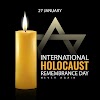The Holocaust
The Holocaust was the Nazi regime's systematic extermination of Jews and other minority groups in Europe during World War II. The Holocaust, also known as the Shoah, killed six million Jews and five million members of other minority groups such as Roma, homosexuals, disabled people, and political prisoners. The Holocaust is widely regarded as one of the most heinous acts of human cruelty in history.
When Adolf Hitler and the Nazi party came to power in Germany in 1933, the Holocaust began. Hitler considered the Aryan race to be superior to all others, and he saw Jews as a threat to the purity of the German race. To achieve his objectives, Hitler implemented a number of anti-Semitic policies aimed at suppressing and marginalizing Germany's Jewish population. Jews were denied civil rights, jobs, and property, and they faced frequent violence and persecution.
With the beginning of the Second World War in 1939, the persecution of Jews intensified. The Nazis quickly conquered Poland and other neighboring countries, subjecting Jews in these areas to even harsher treatment. They were forced into ghettos, which were squalid and overcrowded neighborhoods in which Jews were concentrated. The ghetto conditions were inhumane, and many Jews died of disease and starvation.
In 1941, the Nazis began carrying out the "Final Solution," a plan to systematically exterminate Europe's Jewish population. The Jews were rounded up and forced onto trains bound for concentration camps, where they endured brutal conditions and forced labor. The camps were designed to be death camps, and the prisoners suffered atrocities such as beatings, starvation, and medical experiments. The most notorious of these camps was Auschwitz, which killed an estimated 1.1 million people, mostly Jews.
The Nazis began transporting Jews to extermination camps in 1942 and 1943, bringing the Holocaust to a close. The prisoners were immediately gassed in these camps, which was the primary method of extermination. The gas chambers were styled after showers, but instead of water, the prisoners were exposed to a toxic gas that killed them in minutes. Other methods of extermination used by the Nazis included mass shootings and gas vans.
When the Allies defeated the Nazi regime and liberated the concentration camps in 1945, the world witnessed the horrors of the Holocaust for the first time. The magnitude of the atrocities shocked and horrified the world, and many people demanded justice for the victims and their families. In 1945, the Nuremberg Trials took place, and several key Nazi leaders were tried and convicted for crimes against humanity.
The Holocaust's legacy has had a profound impact on the world, serving as a reminder of the horrifying consequences of hatred and prejudice. The Holocaust has inspired countless works of art, literature, and film, and it has become one of history's most studied events. Today, the Holocaust is remembered as one of human history's darkest chapters, and it serves as a powerful reminder of the importance of promoting peace, equality, and human rights.
To summarize, the Holocaust was a tragedy of unfathomable proportions, and it will be remembered as one of the most heinous acts of human cruelty in history. The Nazis committed heinous acts of violence and genocide against Jews and other minority groups, killing millions of innocent people. The Holocaust's legacy serves as a powerful reminder of the terrible consequences of hatred and prejudice, as well as the importance of promoting peace, equality, and human rights.
The Holocaust history
The Holocaust, also known as the Shoah, was a systematic extermination of six million Jews and millions of other minority groups during World War II by Nazi Germany and its collaborators, including Romas, disabled people, political dissidents, and homosexuals. When the Nazis took power in Germany in 1933, they immediately began persecuting Jews and other minority groups. The Nazis enacted the Nuremberg Laws in 1938, stripping Jews of their citizenship and making intermarrying between Jews and Germans illegal.
In September 1939, Nazi Germany invaded Poland, kicking off World War II. The Nazis quickly established ghettos in occupied territories, forcing Jews and other minority groups to live in cramped, unsanitary conditions. In 1941, the Nazis began rounding up Jews and other minority groups and transporting them to concentration and extermination camps spread across occupied Europe.
Auschwitz-Birkenau, located in German-occupied Poland, was the largest and most infamous of these camps. This camp became the main extermination center for Jews and other minority groups. The Nazis used gas chambers and crematoria to murder people on a large scale. The bodies of those who were murdered were either buried in mass graves or cremated. The Nazis also used slave labor, forcing people to work in camps and factories until they were physically incapable of doing so, at which point they were murdered.
In 1945, the Allies, led by the United States, the United Kingdom, and the Soviet Union, defeated Nazi Germany. When the Allies liberated the concentration and extermination camps, they discovered the horrors of the Holocaust.
The Holocaust left an indelible mark on the world. Millions of lives were lost, and those who survived experienced physical and emotional trauma. The world was shocked by the scale and brutality of the extermination and vowed that such a tragedy would never happen again. The United Nations was established in part to respond to the Holocaust, with the goal of preventing future genocides.
Other genocides and mass atrocities have occurred in the years since the Holocaust, but the memory of the Holocaust remains a powerful reminder of the dangers of prejudice and hatred. To honor the victims and educate future generations about the dangers of prejudice and intolerance, memorials, museums, and educational programs have been established. The Holocaust will continue to inspire those working to create a more just and equitable world in which all individuals are treated with dignity and respect.
The Holocaust facts
The Holocaust was a dark period in human history in which the Nazi regime murdered millions of people, primarily Jews, during World War II. From 1933 to 1945, the Nazi government implemented policies that resulted in the genocide of six million Jews, as well as countless others such as homosexuals, disabled people, and political dissidents.
The rise of the Nazi party in Germany and its leader, Adolf Hitler, was the root cause of the Holocaust. Hitler and the Nazi party believed that Jews were inferior and responsible for the country's problems. Hitler was appointed Chancellor of Germany in 1933, and he quickly established a dictatorship. He then implemented policies aimed at annihilating Jews and other groups.
The Nuremberg Laws, which stripped Jews of their citizenship and made intermarrying with non-Jewish Germans illegal, were one of the Nazi government's first acts. The laws also made the Star of David a required symbol for Jews to wear on their clothing. Over the next few years, Jews and other minority groups were gradually evicted from their homes and deported to ghettos or concentration camps.
Prisoners were forced to live and work in concentration camps under harsh conditions. The camps housed people deemed dangerous to the Nazi regime, such as political dissidents, gypsies, and Jews. These camps evolved over time into extermination camps where prisoners were sent to die.
The Nazis officially launched the "Final Solution" in 1942, a plan to exterminate all Jews in Europe. The Final Solution entailed transporting Jews and other groups to extermination camps, where they were either killed instantly or worked to death. The most common method of murder was gassing, which was accomplished with the chemical Zyklon B.
The Holocaust's horrors were not limited to the extermination camps. Jews and other detainees were subjected to atrocities such as forced labor, starvation, disease, and torture. Inmates were also subjected to medical experiments in which Nazi doctors attempted to improve their race through heinous procedures.
The Holocaust came to an end with the end of World War II. When Allied forces discovered the concentration camps in 1945, the world was stunned by the horrors they discovered. Many of the survivors were physically and emotionally scarred, and the Holocaust's legacy will affect future generations.
The Holocaust's scope is difficult to comprehend. Over six million Jews, as well as millions of others, including homosexuals, people with disabilities, and political dissidents, were murdered. The atrocities committed during the Holocaust serve as a reminder of humanity's capacity for evil.
The Holocaust is remembered today through museums, memorials, and educational programs. The Holocaust's lessons are taught to future generations to ensure that such atrocities do not occur again. The international community must always remember the Holocaust and ensure that its lessons are never forgotten.
The Holocaust is a tragic chapter in human history that serves as a reminder of humanity's capacity for evil. The world must remember the Holocaust and work to prevent similar atrocities from occurring in the future. Only by remembering the past can we hope to avoid such horrors in the future.




0 মন্তব্যসমূহ